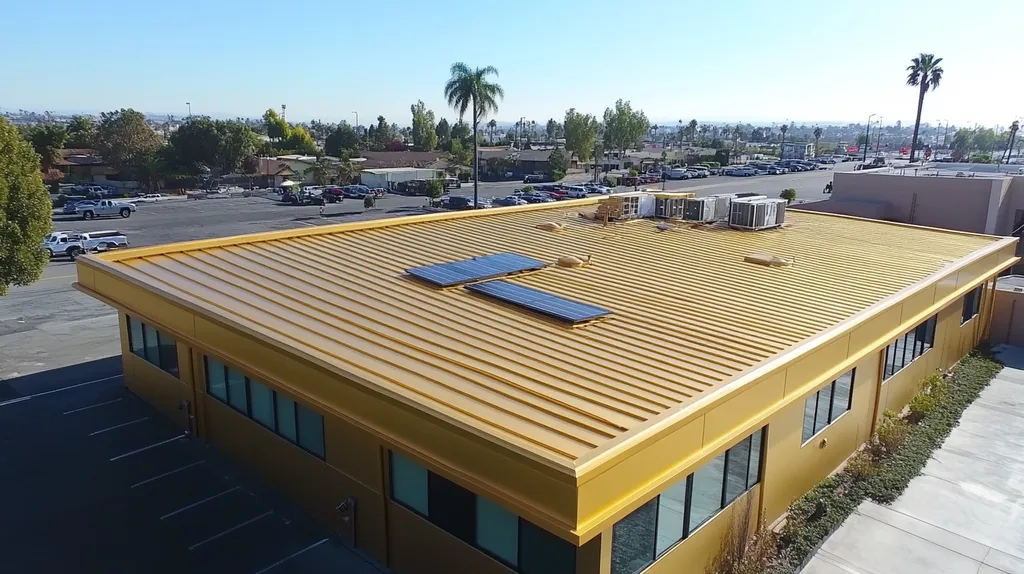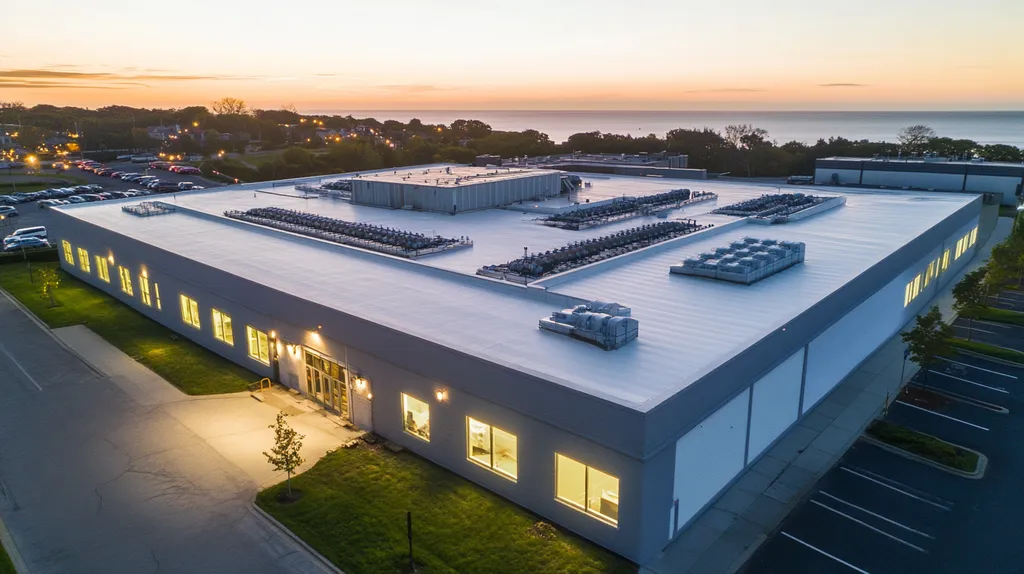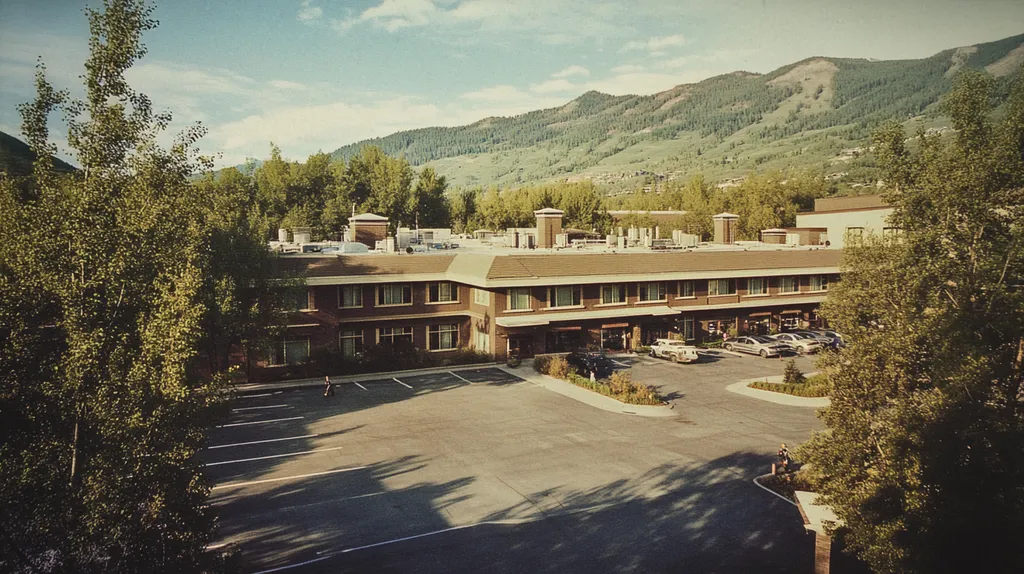In industrial facilities across America, over 30% of roof-related electrical failures stem from improper connections and outdated installation methods, resulting in millions in damages annually.
The stakes couldn’t be higher: faulty electrical connections in industrial roofing systems not only threaten operational continuity but also pose severe safety risks and compliance violations.
From embedded conduit myths to solar reflectance oversights, misconceptions about electrical connections continue to plague the industry, demanding immediate attention from facility managers and property owners.
This comprehensive analysis separates fact from fiction, examining critical aspects of electrical installations in industrial roofing while providing evidence-based solutions for ensuring safety, compliance, and longevity.
SECTION 1: COMMON MISCONCEPTIONS
Misunderstandings about electrical connections in industrial roofing systems can lead to not only costly repairs but also significant safety risks. Common myths surrounding embedded conduits, improper wire covering materials, and the importance of solar reflectance can mislead property owners and facility managers. Addressing these misconceptions is key for those seeking secure and efficient roofing solutions. This section shines a light on these prevalent misunderstandings and their serious implications for the industry.
Embedded Conduit Myths
Many people mistakenly believe that embedding electrical conduits within roofing systems guarantees their safety. This assumption is dangerous; while embedded conduits may seem protected, they are still vulnerable to environmental factors. Moisture intrusion and corrosion can quickly turn a hidden conduit into a ticking time bomb, causing unexpected electrical failures.
For instance, while PVDF coatings provide a degree of protection, they often fall short against prolonged UV exposure and extreme temperatures. A safer approach is to install conduits above the roofing surface, or to utilize waterproof materials specifically tailored for these conditions.
The variety of codes and regulations complicates this further, as what is acceptable in one region may not be in another. This inconsistency can lead to significant liability concerns for property owners and facility managers.
A solid understanding of local building codes and appropriate material choices is essential for successful conduit installation. Being aware of these important factors can prevent expensive repairs and extend the lifespan of roofing systems.
Incorrect Wire Covering Materials
A widespread misconception is that any wire covering material will suffice for industrial roofing systems. This false belief can pose serious safety hazards, particularly in environments subject to temperature shifts and chemical exposure. Inferior materials can deteriorate quickly, resulting in electrical shorts or even fires.
Traditional wire covering materials like PVC are often inadequate for the demanding conditions on industrial rooftops. It’s crucial to select materials that provide high heat resistance and comply with applicable safety standards to ensure long-term reliability.
Additionally, relying solely on manufacturers’ guidelines may not be enough. Facility managers frequently overlook proper installation techniques, which play a significant role in the durability and performance of wiring under challenging conditions.
Conducting a comprehensive evaluation of wire covering materials can greatly mitigate potential hazards while improving operational efficiency. Prioritizing quality and suitability is essential for maintaining a safe and effective roofing system over time.
Ignoring Solar Reflectance
Overlooking solar reflectance is a critical mistake many companies make in their roofing decisions. A common myth suggests that the color of roofing materials is the only determinant of energy efficiency. In reality, solar reflectance is a major player in the performance and longevity of a roof.
Studies reveal that roofs with higher solar reflectance can lower indoor temperatures by up to 30%. This cooling effect translates to lower energy consumption and reduced utility bills, in addition to minimizing the carbon footprint.
Neglecting solar reflectance can also adversely affect the lifespan of roofing materials. Excess heat accelerates wear and tear, often leading to premature roof replacements and escalating maintenance costs.
Choosing materials with a high solar reflectance rating not only contributes to environmental sustainability but also results in significant long-term savings. Budding a strategy that incorporates solar reflectance considerations is essential for maximizing roofing efficiency and longevity.
SECTION 2: PRACTICAL IMPLICATIONS
The integration of electrical connections in industrial roof systems is not merely a technical concern; it poses significant risks that can undermine safety, durability, and maintenance. Alarmingly, statistics indicate that improper installations account for 30% of all roofing failures, resulting in costly downtime and repairs. For property owners and facility managers, addressing these challenges is crucial—not just for compliance but for preserving both functionality and safety. This section explores the urgent safety risks, impacts on roofing durability, and complications that arise during roof maintenance.
Safety Risks and Code Violations
Electrical installations on roofs hide serious safety risks that are often underestimated. Faulty connections can spark electrical fires, which endanger both personnel and the structural integrity of the building. Additionally, failing to comply with local electrical codes can lead to hefty fines and legal repercussions, compounding the financial strain on the operation.
For instance, outdated wiring may harbor hidden dangers, only to be uncovered during inspections. These oversights can trigger unexpected shutdowns, disrupting normal operations and potentially resulting in significant financial losses. Risk management begins with high-quality installation processes and a strict adherence to contemporary safety standards.
Maintaining proper documentation of all electrical connections is essential. This documentation not only ensures compliance but is invaluable during routine inspections to help identify potential hazards. Property owners must recognize that the responsibility for safety extends beyond mere adherence to codes; proactive risk management is equally crucial.
Investing in certified professionals for electrical work is a game changer. It fosters long-term safety by ensuring that all installations comply with regulations and industry best practices, dramatically reducing the chances of accidents occurring on the roof or within the facility.
Impact on Roofing Element Durability
Elevating the risk of roofing element durability is the improper execution of electrical connections. A common outcome of poorly sealed connections is moisture infiltration, leading to material degradation and eventual roof failure. As a result, the integrity of the entire roofing system becomes jeopardized.
Moreover, excessive heat generated by electrical systems can warp roofing materials over time, increasing the risk of leaks. For example, thermoplastic systems may shrink around electrical fixtures, creating vulnerabilities that shorten the roofing system’s lifespan.
Additionally, the incorrect positioning of electrical components can obstruct maintenance access, leaving the roof susceptible to long-term damage due to neglected inspections or improper care. Property owners should ensure that installations are optimized for efficiency and protective measures.
Carefully selecting materials and installation techniques can significantly enhance roof longevity. By investing time in thorough planning, property managers can ensure that electrical connections contribute positively to overall roofing performance.
Complications in Roof Maintenance
Regular roof maintenance can become increasingly complex due to the presence of electrical connections. If maintenance staff are unaware of the location and condition of the electrical systems, they risk damaging components during routine inspections or repairs.
Furthermore, roofs laden with multiple electrical installations may require specialized knowledge for effective maintenance. This necessity can lead to rising operational costs, as facilities might need to hire external experts for routine checks. Overlooking proper training for regular staff only exacerbates these complications.
Conducting periodic assessments of electrical installations is essential for early identification of issues. This proactive approach not only preserves the roof’s integrity but also enhances overall safety. Strategically managing the maintenance of electrical systems can further reduce roof replacement costs, highlighting the importance of a well-planned maintenance strategy.
Ultimately, an organized approach to maintenance is vital for preventing unforeseen complications. Establishing a maintenance schedule that incorporates electrical systems is key to sustaining the health of the entire roofing structure.
SECTION 3: COST OF MISINFORMATION
The stakes of misinformation regarding electrical connections in industrial roofing systems are alarmingly high. Misunderstanding code compliance can lead to expensive upgrades, penalties, and prolonged operational disruptions. Recent industry surveys show that nearly 30% of facilities report incurring unexpected costs due to code-related issues. This section delves into the financial fallout from code noncompliance, escalating maintenance expenses, and the potential liabilities that can arise.
Financial Consequences of Code Noncompliance
Violating electrical codes can impose a heavy financial toll on property owners. Building codes are designed to promote safety and efficiency; when these regulations are ignored, the penalties can quickly escalate. Municipalities may impose fines that compound with each violation, potentially amounting to thousands of dollars.
In addition to fines, retrofitting existing roofing systems to achieve compliance can be prohibitively expensive. Many property owners find themselves spending far more to correct mistakes than they would have spent on a proper installation from the outset. Furthermore, delays caused by inspections and necessary modifications can lead to missed deadlines, further inflating costs.
These financial burdens are not one-time events; they can set a troublesome precedent for future projects, disrupt budgets, and create long-term fiscal issues. Staying well-informed is vital, as misunderstandings often lead to irreversible financial consequences.
Investing in compliance from the start can safeguard facilities in the long run. The industry is increasingly aware that taking shortcuts often results in far more significant costs down the line. Familiarity with local codes can significantly reduce these risks and promote better expense predictability.
Increased Maintenance and Repair Costs
Inaccurate information about electrical systems significantly contributes to rising maintenance and repair costs. Improper installations lead to premature system failures that require frequent fixes or even complete replacements. For instance, a poorly sealed electrical connection can allow water infiltration, which may lead to mold growth and damage that compromises the roofing structure.
Such ongoing repairs often arise from shortcuts taken during the initial setup, rooted in a misunderstanding of electrical standards. The financial strain of continuous repairs can eclipse any initial savings from avoiding proper installations or quality materials. Instead of serving as an investment in the longevity of the asset, regular maintenance becomes an unwelcome expense.
The impact of these inflated maintenance costs extends beyond the financial realm, disrupting business operations. Facilities plagued by persistent electrical issues may face costly downtimes that erode revenue and productivity. Understanding accurate information is essential when planning and executing installations, as early decisions significantly shape maintenance costs.
Ultimately, the long-term lifecycle costs of roofing systems are closely intertwined with the quality of the information used for setup and electrical compliance. Property owners must prioritize transparent communication with contractors to minimize these risks.
Potential Liability and Insurance Issues
The liability potential linked to misinformation regarding electrical connections is substantial. If an electrical failure occurs because of noncompliance, property owners may be exposed to lawsuits and hefty legal fees. For example, an electrical fire caused by a faulty installation could lead to injury, loss of life, and severe legal consequences for the involved parties.
Moreover, insurance claims associated with electrical failures can be complicated by compliance documentation. Insurers may deny claims if they find that the facility violated electrical codes, forcing property owners to shoulder repair costs personally. This vulnerability can destabilize operations and add financial strain.
Unsound electrical practices can also lead to higher insurance premiums or difficulties securing coverage altogether. Insurance companies typically scrutinize compliance histories; frequent violations signal greater risks, translating into elevated costs for business owners. Taking proactive measures to ensure proper installations can substantially mitigate these risks.
Recognizing the link between informed electrical installation and potential liability is crucial for property owners. By maintaining clear documentation and ensuring compliance, facilities can enhance safety and protect against both financial and legal repercussions.
SECTION 4: REALITY CHECK
Electrical connections on industrial roofs are not merely technical details; they can have significant safety and compliance implications. According to the National Fire Protection Association, improper electrical installations can lead to devastating fires, endangering both property and lives. To mitigate these risks, it’s vital for facility managers and property owners to understand the National Electrical Code (NEC) requirements, industry standards, and best practices for wire placement.
National Electrical Code Requirements
The National Electrical Code (NEC) lays the groundwork for electrical safety in industrial roofing systems. Compliance with these regulations is not simply recommended; it’s essential for protecting both equipment and personnel. For instance, Section 300.5 of the NEC outlines crucial guidelines for underground installations, including proper burial depths and necessary protective measures.
Moreover, adhering to specific guidelines for conduit installations can significantly minimize the risks associated with corrosion and damage. Facilities that rely on outdated installations not only jeopardize compliance but also expose themselves to critical safety hazards. Regular audits and timely updates are imperative to ensure ongoing alignment with NEC standards.
Staying informed about amendments to NEC regulations is essential for facility managers seeking to maintain compliance. As updates occur, they reflect advancements in technology and safety protocols—failure to keep up can increase risk and liability.
Ultimately, strict adherence to the NEC not only safeguards property but also enhances the credibility and trustworthiness of the facility management process. Ensuring compliance acts as a proactive measure that yields significant dividends in safety and reputation.
Industry Standards for Roofing Conduits
Industry standards for roofing conduits define the installation and maintenance protocols for electrical systems. Organizations like the American National Standards Institute (ANSI) establish guidelines covering material selection, installation practices, and maintenance procedures. Utilizing appropriate conduit materials prevents deterioration and ensures the integrity of electrical systems.
For example, non-metallic conduits are frequently recommended for areas where moisture is prevalent. The careful selection of materials and adherence to best installation practices can dramatically reduce failure risks arising from environmental factors. Neglecting these industry standards can lead to premature wear and costly repairs.
Additionally, choosing wiring that meets or surpasses current industry specifications is vital for safeguarding electrical connections. Regular training sessions for maintenance staff on these standards can bolster compliance efforts and enhance safety.
Failure to adhere to industry guidelines can trigger operational disruptions and longer downtimes. Staying aware of these standards and committing to them is essential for effective facility management.
Best Practices for Wire Placement
Proper wire placement transcends aesthetic concern; it’s paramount for safety and operational efficiency. Best practices suggest wiring should be routed away from high-traffic zones, reducing the chances of accidental damage. For instance, positioning conduits along the roof’s perimeter helps avoid interference with rooftop machinery or foot traffic.
Moreover, implementing strain relief methods during wiring installation can significantly mitigate the likelihood of electrical failures. Protecting wires from environmental elements is not just a compliance issue but a matter of operational reliability.
Utilizing weather-resistant materials for wire insulation enhances durability, shielding against UV degradation and temperature fluctuations. Such measures not only extend the life cycle of the electrical systems but also help lower ongoing maintenance expenses.
Ultimately, prioritizing best practices for wire placement enables facility managers to maintain operational and effective electrical systems. This vigilance contributes meaningfully to the overall safety and functionality of the roofing systems.
SECTION 5: EVIDENCE-BASED ALTERNATIVES
The importance of making informed decisions about electrical connections in industrial roofing cannot be overstated. Faulty installations can lead not only to safety hazards, such as increased fire risks, but also to potential legal repercussions for property owners. Non-compliance with electrical codes has resulted in numerous legal claims, creating financial strains for businesses. This section highlights critical alternatives that prioritize safety and adherence to regulations while also enhancing the durability of integrated electrical systems.
Using Approved Conduit Materials
Choosing approved conduit materials is vital for maintaining the integrity of electrical systems on industrial roofs. The misuse of non-compliant materials exposes wiring to environmental threats, increasing the likelihood of system failures.
By utilizing approved conduits, such as rigid metal and PVC, property owners can protect their electrical systems against corrosion and physical damage. This proactive choice significantly reduces the chances of electrical shorts and extends the overall lifespan of the system.
Additionally, these approved materials ensure compliance with the National Electrical Code (NEC), which sets the standard for electrical safety across the United States. Adhering to these guidelines not only enhances building safety but also minimizes the risk of litigation and rejection of insurance claims.
Although upgrading to approved conduit materials necessitates an initial investment, the long-term savings from reduced maintenance costs and enhanced reliability make this a wise business decision.
Implementing Solar Reflective Wire Coverings
Rising temperatures on industrial roofs can pose serious threats to electrical systems. Implementing solar reflective wire coverings offers a practical and effective solution to combat this challenge.
These innovative coverings help dissipate heat and protect wiring from thermal damage, ultimately prolonging their functional life. Research indicates that without adequate protection, electrical components are vulnerable to overheating, which can lead to costly failures.
Beyond durability, solar reflective coverings enhance energy efficiency by reducing heat gain in the electrical systems. This dual benefit not only extends the lifespan of the systems but can also contribute to lower energy expenses over time.
Adopting solar reflective materials aligns facilities with sustainable practices, showcasing a strong commitment to both innovation and efficiency.
Proper Installation Methods for Wiring
Proper installation methods are crucial for ensuring the safety and longevity of electrical systems in industrial roofing. Unfortunately, rushed installations and inadequate training often lead to improper methods that compromise system integrity.
Best practices dictate securing wiring with appropriate fasteners and steering clear of sharp edges. Implementing layered protective measures, such as using conduits and tray systems, adds essential safety features to the installation.
Regular inspections during and after the installation process are imperative for early identification of any potential issues. These proactive measures not only strengthen system integrity but also ensure compliance with regulatory standards.
Ultimately, investing in skilled labor and providing thorough training equips installers to meet the highest standards. This commitment significantly reduces liabilities while fostering trust among property owners and facility managers.
SECTION 6: TEST AND VERIFY
Electrical connections in industrial roof systems are not just minor details; they are pivotal for ensuring safety and operational efficiency. Neglecting regular inspections can lead to catastrophic failures and put both the property and its occupants at risk. Alarmingly, research indicates that faulty electrical connections account for nearly 25% of roofing system failures. This section underscores the critical importance of routine electrical testing, assessing thermal efficiency, and verifying compliance with National Electrical Code (NEC) guidelines.
Conducting Regular Electrical Inspections
Conducting frequent electrical inspections is essential for preserving the integrity of industrial roof systems. These assessments enable the early detection of potential issues, preventing costly repairs and hazardous situations. Inspections should encompass a thorough review of connections, wiring, and protective systems, with a keen eye for any signs of deterioration or corrosion.
Experts recommend performing these inspections at least twice a year, particularly before and after severe weather events. Delaying inspections can significantly heighten the risk of electrical arcing or short circuits, endangering not only the roofing system but also the safety of the entire building.
Utilizing advanced technology such as infrared thermography and electrical testers can greatly enhance the inspection process. These tools reveal potential concerns that may not be visible during a standard check. Additionally, maintaining thorough documentation of inspection results is crucial for tracking the health of the electrical system over time.
Ultimately, investing in regular inspections represents a proactive approach to securing a safe and efficient roof system. This practice aligns with industry standards and fosters a culture of safety and responsibility among facility managers and property owners.
Testing for Thermal Efficiency
Evaluating the thermal efficiency of electrical systems integrated into industrial roofs is vital for ensuring optimal performance. Using thermal imaging can help identify hotspots caused by overheated components, which may signify imminent failures. By addressing these issues promptly, property owners can prevent wasteful energy consumption and preserve the structural integrity of the roof.
Additionally, moisture accumulation around electrical connections can degrade insulation over time. Regular thermal efficiency tests play a critical role in pinpointing areas that require remediation, mitigating potential damage before it escalates. The data gathered from these assessments can inform necessary upgrades or ongoing maintenance tasks.
Moreover, the performance of rooftop HVAC systems, which often integrate electrical connections, relies heavily on thermal efficiency. Ensuring these systems are functioning correctly is essential for maintaining indoor air quality and comfort. Effective testing can lead to lower energy costs and enhanced sustainability.
Investing in thermal efficiency not only protects the functionality of the roof but also contributes to reduced operational expenses and a smaller carbon footprint. Embracing this approach reflects a commitment to advancing industrial roofing practices.
Verifying Compliance with NEC Guidelines
Adhering to NEC guidelines is non-negotiable for ensuring the safety and reliability of electrical connections in roof systems. The NEC lays out essential regulations designed to uphold safety standards for electrical installations. Non-compliance can result in severe safety risks and regulatory penalties that could jeopardize business operations.
Facility managers must regularly verify that all electrical components and installations align with NEC guidelines. This involves checking wiring methods, grounding practices, and equipment ratings to ensure that the roofing system can safely endure various environmental conditions.
Furthermore, documenting compliance with NEC guidelines facilitates smoother inspections by local authorities. Having clear evidence of adherence to these standards can prevent costly downtimes and ensure seamless operational continuity. This proactive stance enhances the safety environment for all building occupants.
Ultimately, verifying compliance with NEC regulations not only boosts the durability and reliability of roofing systems but also solidifies a foundation of safety and trust, contributing significantly to effective facility management.
Moving Forward
With over $2 billion in annual damages attributed to faulty electrical connections in industrial roofing systems, the stakes couldn’t be higher for facility managers and property owners.
The evidence is clear: proper electrical installations, regular inspections, and strict compliance with NEC guidelines are non-negotiable components of a safe and efficient industrial roof system.
Solar reflective materials, approved conduits, and professional installation methods have proven critical in preventing catastrophic failures while maximizing system longevity.
By embracing evidence-based practices and maintaining rigorous testing protocols, facility managers can protect their assets, ensure regulatory compliance, and significantly reduce long-term operational costs.
The future of industrial roofing depends on raising industry standards and eliminating dangerous misconceptions about electrical connections once and for all.
FREQUENTLY ASKED QUESTIONS
Q. What are common misconceptions about electrical connections in commercial roofs?
A. Many believe that embedding conduits makes them safe, but environmental factors can lead to failures. Choosing waterproof materials and understanding local codes is crucial for safe installations.
Q. How can improper connections affect industrial roofing systems?
A. Faulty connections can spark fires and lead to significant compliance issues. Adhering to codes and maintaining high-quality installations enhances safety and reduces financial risks associated with failures.
Q. What are the costs associated with misinformation in commercial roofing?
A. Misunderstood codes often result in expensive fines and necessary retrofits. Staying informed from the start can prevent unnecessary financial burdens and ensure a smoother installation process.
Q. Why is adherence to the NEC vital for industrial roofing?
A. Compliance with NEC guidelines ensures electrical safety and prevents potential hazards. Staying up-to-date with changes in regulations protects property and enhances credibility within facility management practices.
Q. What are approved materials for electrical conduits on industrial roofs?
A. Using approved conduit materials like rigid metal and PVC minimizes corrosion risks. Compliance with electrical codes is critical for ensuring system longevity and protecting against potential failures.
Q. How can I assess the thermal efficiency of electrical systems?
A. Regular thermal imaging tests help identify hotspots and moisture issues affecting wiring. Addressing these concerns can boost energy efficiency and protect the structural integrity of the roofing system.
Q. What training is essential for staff managing industrial roof maintenance?
A. Regular training should cover electrical safety standards, installation best practices, and emergency responses. Properly trained staff are essential for maintaining system integrity and ensuring compliance with industry standards.











